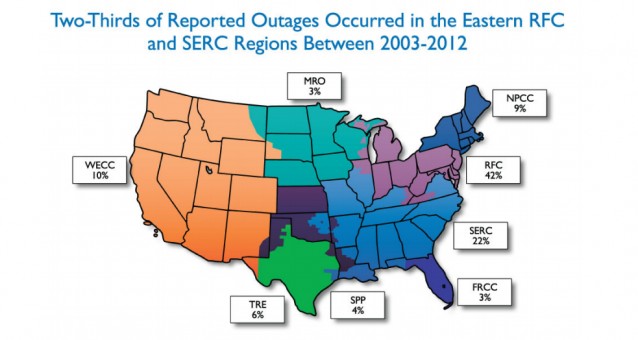A
new report from Climate Central has found that major power outages have increased ten times over since the early 1980s - and extreme weather is by far the biggest culprit.
The analysis defined a "major power outage" as a loss of electrical power for at least 50,000 people for at least an hour, or where the power supply interruption reached at least 300 megawatts, or where demand exceeded supply by at least 100 megawatts. It found the big upswing in such events occurred in the 2000s. Weather drove 80 percent of all outages between 2003 and 2012, and only three years in that time period saw non-weather related events account for more than 10 percent of all outages.
Furthermore, the average number of weather-related outages doubled over the 2003-2012 period. More specifically, 59 percent of the weather-related outages covered by the analysis were due to storms and extreme weather; 19 percent were due to severe cold and ice storms; 18 percent were due to hurricanes and tropical storms; 3 percent were due to tornadoes; and 2 percent were caused by extreme heat and wildfires.
Now, it's possible that variables other than climate change are contributing to this trend. But the report notes that the nation's power system has remained largely unchanged over the last 50 years. So it's unlikely alterations to the make-up or extent of the grid are responsible.
How outages are reported has also changed, which could drive up the numbers as methods become more rigorous. To get at that possibility, Climate Central broke down the trends in weather-related versus non-weather-related outages. The two diverge sharply beginning around 2000, as the former goes up while the latter remains almost unchanged. Which suggests changes in reporting aren't a big factor either.
Finally, there's the simple fact that the grid is aging and thus more vulnerable than it used to be. So climate change is not the sole factor, Climate Central concluded. But it appears
to be a major one.
The report cites both the U.S. National Climate Assessment and the Intergovernmental Panel on Climate Change to point out that heavy downpours, and the heavy winds that sometimes accompany them, have increased dramatically in some parts of the country since the late 1950s - up 74 percent in the Northeast, and up 45 percent in the eastern half of the Midwest. Heat waves have also gone up, with the 2000s seeing more than any other decade of the previous century. Storm and hurricane strength is a bit harder to nail done, but the report finds evidence that winter storms and Atlantic hurricanes have increased in power recently.
Put it all together and two-thirds of the reported outages from 2003 to 2012 occurred in the lower Northeast (45 percent) and the bulk of the South (22 percent).

© Climate Central
The top ten states most affected by weather-related outages were, in descending order, Michigan, Texas, Ohio, Pennsylvania, Virginia, Maryland, North Carolina, California, Illinois, and Indiana. Since 2003, 147 million customers experienced a "major power outage" as defined in the analysis - an average of 15 million customers a year.
Climate Central also notes that most of the economic cost from these outages is not due to repairs, but due to the indirect consequences: water treatment facilities left off, hospitals brought to a standstill, businesses forced to temporarily close, etc. The report cites work estimating that, as of 2001, the annual costs of such outages ranged from $100 billion to $164 billion.
It's because the infrastructure is falling apart. The places with the largest % of outages are also the places with the oldest systems. More propaganda as far as I'm concerned.